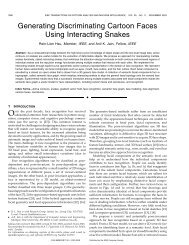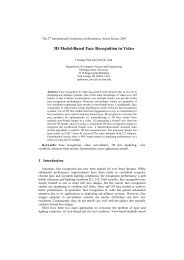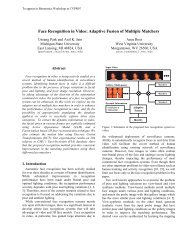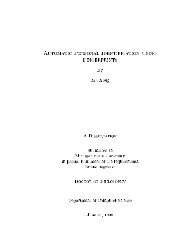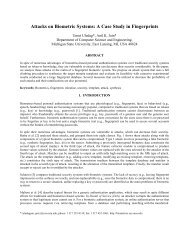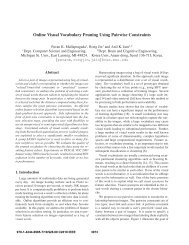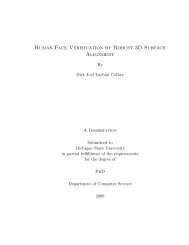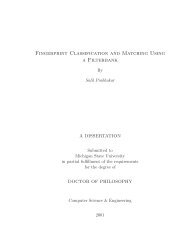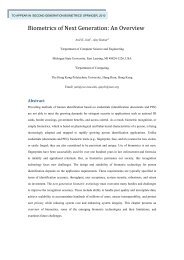Face Detection and Modeling for Recognition - Biometrics Research ...
Face Detection and Modeling for Recognition - Biometrics Research ...
Face Detection and Modeling for Recognition - Biometrics Research ...
Create successful ePaper yourself
Turn your PDF publications into a flip-book with our unique Google optimized e-Paper software.
mation theory, geometrical modeling, (de<strong>for</strong>mable) template matching, Hough trans<strong>for</strong>m,<br />
extraction of geometrical facial features, motion extraction, <strong>and</strong> color analysis.<br />
Typical detection outputs are shown in Fig. 2.1. In these images, a detected face<br />
is usually overlaid with graphical objects such as a rectangle or an ellipse <strong>for</strong> a face,<br />
<strong>and</strong> circles or crosses <strong>for</strong> eyes.<br />
The neural network-based [24], [23] <strong>and</strong> the viewbased<br />
[25] approaches require a large number of face <strong>and</strong> non-face training examples,<br />
<strong>and</strong> are designed primarily to locate frontal faces in grayscale images. It is difficult<br />
to enumerate “non-face” examples <strong>for</strong> inclusion in the training databases. Schneiderman<br />
<strong>and</strong> Kanade [22] extend their learning-based approach <strong>for</strong> the detection of<br />
frontal faces to profile views. A feature-based approach combining geometrical facial<br />
features with belief networks [26] provides face detection <strong>for</strong> non-frontal views.<br />
Geometrical facial templates <strong>and</strong> the Hough trans<strong>for</strong>m were incorporated to detect<br />
grayscale frontal faces in real time applications [20]. <strong>Face</strong> detectors based on Markov<br />
r<strong>and</strong>om fields [27], [87] <strong>and</strong> Markov chains [88] make use of the spatial arrangement<br />
of pixel gray values. Model based approaches are widely used in tracking faces <strong>and</strong><br />
often assume that the initial location of a face is known.<br />
For example, assuming<br />
that several facial features are located in the first frame of a video sequence, a 3D<br />
de<strong>for</strong>mable face model was used to track human faces [61]. Motion <strong>and</strong> color are very<br />
useful cues <strong>for</strong> reducing search space in face detection algorithms. Motion in<strong>for</strong>mation<br />
is usually combined with other in<strong>for</strong>mation (e.g., face models <strong>and</strong> skin color) <strong>for</strong> face<br />
detection <strong>and</strong> tracking [89]. A method of combining a Hidden Markov Model (HMM)<br />
<strong>and</strong> motion <strong>for</strong> tracking was presented in [86]. A combination of motion <strong>and</strong> color<br />
filters, <strong>and</strong> a neural network model was proposed in [19].<br />
35



